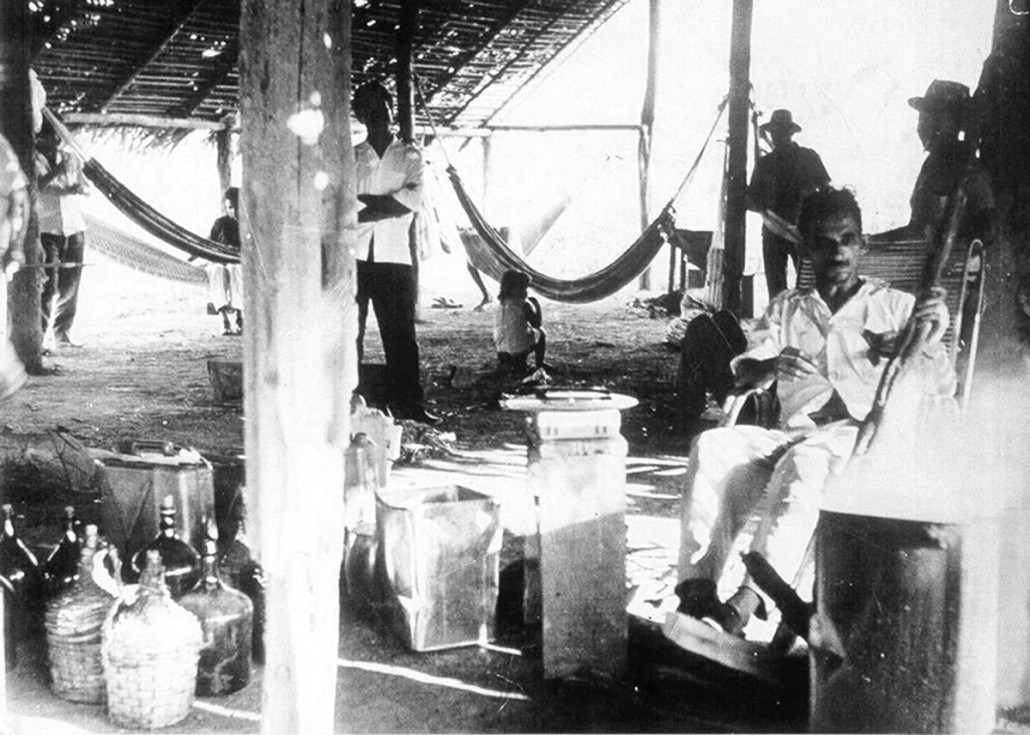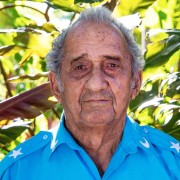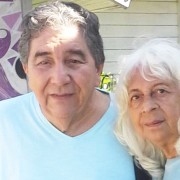Music as an instrument of Mestre Gabriel
In this second publication in homage of the 99 years since the birth of Mestre Gabriel, we’ll speak about music and highlight three compositions important to those who want to know more regarding the União do Vegetal and of Mestre Gabriel. The text is of the authorship of journalist Juliane Oliveira*.
The Gaze of Mestre Gabriel registered in photographs and in his words, repeated to this day by those first brothers who were at his side in the beginning of this Sacred Work, echo in the temples of the Beneficent Spiritist Center União do Vegetal. In the photograph of Mestre Gabriel illuminating the Temples of the UDV, two elements call our attention: a record player and some vinyl discs. They are there, at the left side of the Mestre, not as mere adornments. They are there to serve Mestre Gabriel as they could: being instruments to bring music to the “Salão do Vegetal”. In this way, complementing or bringing a subject according to the necessity of the moment.
Compared to what we have today they were resources in a time of scarce technology. As told by Mestre José Luiz de Oliveira, member of the Council of the Recordation of the Teachings of Mestre Gabriel and Representative Mestre at the General Headquarters, the record player and the vinyl records, were used with skill and assisted Mestre Gabriel to do his work.
“Sometimes, he [Mestre Gabriel] spoke of a certain subject and complemented with a song in the same subject. Or he would play a song to introduce a subject and would bring doctrine on that subject. Music was used by Mestre Gabriel in this way, as a tool for work.”
Adopted since the times of Mestre Gabriel, music is still used today in the “Salāo do Vegetal” allowing us to learn some more about this simple man of great wisdom, who faced the reality of life (Life’s Dilemma), taught us from his experience and continues teaching us. Born in the town Heart of Mary (Coração de Maria in Feira de Santana, Bahia), he was influenced by the wholesome folk music of the last century. Consequently, he brought to his simple home (Uma Casa de Caboclo), the joy, the hope and the motivating force to create a better world. One day, he bid us farewell, but before that he made an acknowledgment (Agradecimento), teaching us once again:
“Everything I do, everything I say and all that I sing is teaching.” (Mestre Gabriel).
Life’s Dilemma
The song Dilema da Vida (Life’s Dilemma) is part of the União do Vegetal’s repertoire. Through this song José Gabriel da Costa, Mestre Gabriel, presents himself to the irmandade of the União do Vegetal and to anyone who wishes to know him. This song, speaking of the difficulties faced by those willing to overcome evil through the practice of goodness, was frequently played when he was present in the sessions in Porto Velho, RO.
And so I live struggling with challenges
Following my belief without giving up
Being clear, telling the truth
And being honest, is hard to win.
Even crossing through difficulties – some of those well known in the hoasqueiro world- Mestre Gabriel always worked for Peace and for Human Fraternity. He never gave up and always demonstrated his conviction of Divine Justice. His belief in a Superior Power is evident in his Sacred Work. With the song Life’s Dilemma, which he often used to teach his disciples to be individuals of value, as he is, Mestre Gabriel once again reveals his conviction:
Indeed, of one thing I am certain
Someone someday will recognize
That I don’t use weapons in my defense
And those who are noble will defend me.
I don’t have greed; I don’t want riches;
I only wish to fulfill my duty
And the one who rules all nature
Will send me the reward I merit.
We are surprised by how Nonô and Naná [composers of the song] managed to express, in the song Life’s Dilemma, the same dilemmas lived by Mestre Gabriel. He himself said, “whoever wants to know me some more, listen to this song”.
The Home of a Simple Man [a caboclo is a dweller of the countryside]
Even today, those who enter the temples of the União do Vegetal encounter a home; a house of many friends. In different ways, sizes and colors, each Nucleo is the fruit of The Home of a Simple Man- the home of “Mr. Gabriel and Mrs. Pequenina”. In this house, as Mestre Florêncio said, one found the shelter and the caring of simple people who build a home for their children and a spiritual school for the many disciples who were already beginning to arrive.
“We arrived at Mestre Gabriel’s home, a dwelling of packed dirt floor, covered with thatch and boards, and the bathroom was way out there in the back yard. It was really a country hut. Mestre Gabriel’s home was simple, truly simple, but it was there that he welcomed us. I was one of those in that simple dwelling, but there we didn’t lack a cup of coffee, a good conversation or a hammock to lay in. Both he and Mestre Pequenina treated us well.” (Excerpt from the book Relicário – Images of the Sertão, by the Journalist Edson Lodi).
According to accounts, one time Mestre Gabriel played the song Uma Casa de Caboclo for Mestre Sidon (in memory) after he had been looking around at the simplicity and the few belongings Mestre Gabriel had. Once again, Mestre Gabriel demonstrated his wisdom. He also invites us to become familiar with his “heaven here on earth”, as in the verses of the song. It reminds us of the Nucleos of the União do Vegetal, which are so joyful with the presence of the children and the youth who accompany their parents to M. Gabriel’s “simple home”. We are the children, thirsty to drink from the spirituality that the Hoasca Tea and the teachings of Mestre Gabriel have to offer us:
A simple little house at the foot of the hill
If you are a friend, you won’t care where I live
Go see up close my heaven here on earth
And meet the children that I love
Acknowledgement (Agradecimento)
As one predicting a farewell, Mestre Gabriel brought from his trip to Fortaleza in Ceará, an LP with the song Acknowledgement (Agradecimento by Severino Ramos and Jacy Santos), from the Trio Nordestino. The song, according to an interview with Mestre José Luiz, was written at the time when one of the three members of the Trio Nordestino became ill. The other two members wrote this song in gratitude. According to Mestre José Luiz, Mestre Gabriel would say it this way: “Through this song, they [Trio Nordestino] were an instrument for me [Mestre Gabriel] to express my gratitude for all the assistance I received in the Hospital in Messejana. For the dedication that the doctors had with me and for the recovery of my health. They think they are doing it for themselves, but they are doing it for me”.
God gave me
Almost everything I wanted
Even the joy of being a son of Bahia
It has been long since I have seen my city
I am going to quench my longing
The day is almost arriving
The song, Acknowledgment, was played for the first time in the União do Vegetal in Porto Velho on March 27, 1971, when Mestre Gabriel returned to Porto Velho, after a long period of treatment in Fortaleza, accompanied by, at that time, counselor Adamir. On that trip, Mestre Gabriel went to Bahia to visit his family. His return to Porto Velho marks a new time in the União do Vegetal. As it also says in the song, Mestre Gabriel points to “the day is arriving” of his departure. And, like a good teacher, he uses music to demonstrate his humility, teaching once again to his disciples the value of gratitude and recognition of God:
“But I thank all that God did for me
To the men of medicine
And the Lord of Bonfim”.
As all that Mestre Gabriel does is teaching, he also used the music as a working tool to teach us, his disciples, how to be a builder of this Sacred Work that is the União do Vegetal- the treasure of Mestre Gabriel.
Video
We present in the video below, these three important songs that are part of the history of Mestre Gabriel and of the União do Vegetal. To produce the video, the team of the UDV Blog worked with Mestre José Luiz de Oliveira, member of the Council of the Recordation of the Teachings of Mestre Gabriel.
–
*Juliane Oliveira is a member of the Instructive Body at the General Headquarters (Brasilia-DF). The text was constructed from an interview held with Mestre José Luiz de Oliveira (member of the Council of the Recordation of the Teachings of Mestre Gabriel and Representative Mestre of the General Headquarters) and information found in the book “Relicário – Imagens do Sertão”, authored by journalist Edson Lodi and General Assistant Mestre of the Beneficent Spiritist Center União do Vegetal.
–
Leave a Reply
Want to join the discussion?Feel free to contribute!
Leave a Reply to Azilda Helena Cordahi Cancel reply
You must be logged in to post a comment.
 English
English Português
Português




Que coisa Linda! A simplicidade do Mestre Gabriel refletida nessas belas canções. Trouxe-me lembrancas saudosas dos tempos de Rondonia, quando escutavamos essas musicas nas sessões. Parabéns à todos os irmaos envolvidos na realização desse belíssimo trabalho. Light, Peace and Love to all.